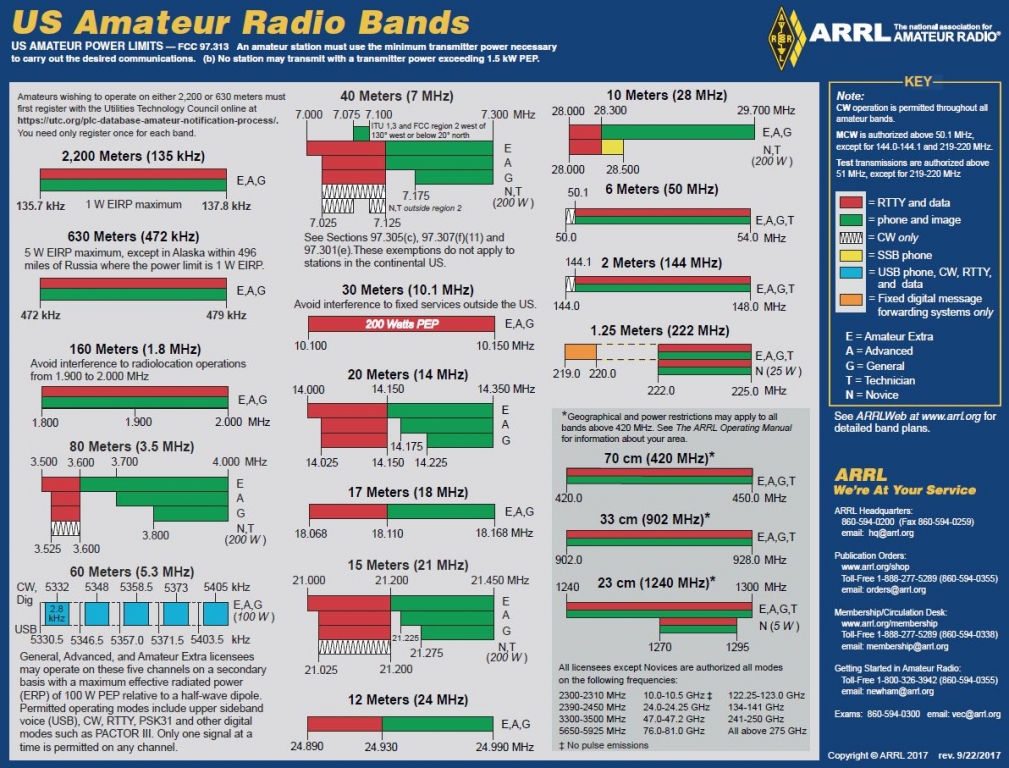Planned radio experiments
Jul 26, 2025 - ⧖ 4 minAt the time of writing, I am still only a ham radio technician license holder. This limits me to a specific subset of the amateur radio frequency bands and an even further subset of operating modes within them. The ARRL band plan describes the operation within each frequency range, and here's a graphical representation of that list including license priviledges: 
I am already up and running on the 2m and 70cm bands (VHF/UHF) using my HT's and Yaesu FTM-510. While I could stand to have a better antenna setup, I feel comfortable with FM operation in those bands, where I've done FM simplex voice and APRS.
However, taking a look at the band plan, there's much more out there that I can access as a technician! There are a few areas within my license class that I'm interested in:
- Digital modes like FT8 on 10m
- SSB voice on 10m
- HF band CW on 40m
I think that the biggest reason these items are intriguing to me is their much larger area of reach. These HF bands can travel much further in the correct propogating conditions. If I can get the proper hardware setup to access these items, it will help me learn and grow as an amateur radio operator. Now, what hardware have I ordered to facilitate this learning?
Hardware incoming
First off, I ordered a (Tr)uSDX transceiver that can run 80/60/40/30/20m bands. This is a small, multi-band QRP transceiver that can handle all modes. It will help me to listen to HF operators, and also give me a chance to transmit on the 40m band when I am comfortable with CW. I'll point out that I also ordered a QRP-Labs QMX kit, and I also have an RTL-SDR that could handle the receiving of these HF signals. However... I'm impatient and I want a backup plan in case my kit assembly of the QMX doesn't go as planned...
Next, I picked up some coaxial cable - a 25' run of RG316. To be frank, I chose it without much care for how lossy it is. Rather, I chose a cheap and portable option. Will I regret this choice? Maybe, and I'll spend accordingly after I get an HF rig in-hand.
Finally, I ordered two antennas: both a 10m and a 40m model of the Par Endfedz QRP antennas. They're short-term solutions that I can certainly use later on as I grow as an operator. As mentioned earlier, my goals are for 10m and 40m bands that I'm licensed for currently as a technician. These antennas were relatively cheap, they're packable, and they were in stock from a reputable vendor (DX Engineering).
Given that the QRP-Labs QMX and the (Tr)uSDX can't handle 10m, I won't be able to transmit on 10m yet with any gear I currently have. However, if I chose to get something like an IC-7100 or an FT-891, then I'll be ready to rock and roll even without having my general license.
Experiments
With my interests and incoming hardware laid out, here's what I plan to do in the coming weeks:
First, I want to string up my 40m antenna and listen for both CW and voice traffic. I think that reaching out to my local friend K0TML will help me troubleshoot if my setup works at all! I can do this with the (Tr)uSDX.
After that, I want to listen on both 40m and 10m for FT8 and see if I can get it to decode properly in WSJT-X. This will require both the (Tr)uSDX and the RTL-SDR for the 40 and 10m bands.
From there... maybe I'll have learned enough to take that general license exam!
About that general
I plan to get my general, however I have been so wrapped up in just playing around with radios at night... it's been tough to study. There's too much great stuff to do in this hobby, and studying isn't what I want to do right now. The items I have purchased are going to be applicable regardless if I get my general license or not by the end of this summer.
With that said... wish me luck, I'm going to go crack a study book now!